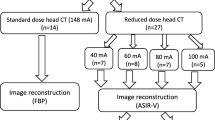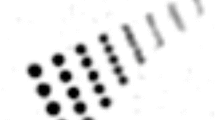Abstract
Background
Over the last decade there has been escalating concern regarding the increasing radiation exposure stemming from CT exams, particularly in children. Adaptive statistical iterative reconstruction (ASIR) is a relatively new and promising tool to reduce radiation dose while preserving image quality. While encouraging results have been found in adult head and chest and body imaging, validation of this technique in pediatric population is limited.
Objective
The objective of our study was to retrospectively compare the image quality and radiation dose of pediatric head CT examinations obtained with ASIR compared to pediatric head CT examinations without ASIR in a large patient population.
Materials and methods
Retrospective analysis was performed on 82 pediatric head CT examinations. This group included 33 pediatric head CT examinations obtained with ASIR and 49 pediatric head CT examinations without ASIR. Computed tomography dose index (CTDIvol) was recorded on all examinations. Quantitative analysis consisted of standardized measurement of attenuation and the standard deviation at the bilateral centrum semiovale and cerebellar white matter to evaluate objective noise. Qualitative analysis consisted of independent assessment by two radiologists in a blinded manner of gray-white differentiation, sharpness and overall diagnostic quality.
Results
The average CTDIvol value of the ASIR group was 21.8 mGy (SD = 4.0) while the average CTDIvol for the non-ASIR group was 29.7 mGy (SD = 13.8), reflecting a statistically significant reduction in CTDIvol in the ASIR group (P < 0.01). There were statistically significant reductions in CTDI for the 3- to 12-year-old ASIR group as compared to the 3- to 12-year-old non-ASIR group (21.5 mGy vs. 30.0 mGy; P = 0.004) as well as statistically significant reductions in CTDI for the >12-year-old ASIR group as compared to the >12-year-old non-ASIR group (29.7 mGy vs. 49.9 mGy; P = 0.0002). Quantitative analysis revealed no significant difference in the homogeneity of variance in the ASIR group compared to the non-ASIR group. Radiologist assessment of gray-white differentiation, sharpness and overall diagnostic quality in ASIR examinations was not substantially different compared to non-ASIR examinations.
Conclusion
The use of ASIR in pediatric head CT examinations allows for a 28% CTDIvol reduction in the 3- to 12-year-old age group and a 48% reduction in the >12-year-old age group without substantially affecting image quality.


Similar content being viewed by others
References
Brenner DJ, Hall EJ (2007) Computed tomography – an increasing source of radiation exposure. N Engl J Med 357:2277–2284
Brenner D, Elliston C, Hall E et al (2001) Estimated risks of radiation-induced fatal cancer from pediatric CT. AJR Am J Roentgenol 176:289–296
Huda W, Atherton JV, Ware DE et al (1997) An approach for the estimation of effective radiation dose at CT in pediatric patients. Radiology 203:417–422
Ozasa K, Shimizu Y, Suyama A et al (2012) Studies of the mortality of atomic bomb survivors, report 14, 1950-2003: an overview of cancer and noncancer diseases. Radiat Res 177:229–243
Kalra MK, Maher MM, Toth TL et al (2004) Techniques and applications of automatic tube current modulation for CT. Radiology 233:649–657
Greess H, Lutze J, Nomayr A et al (2004) Dose reduction in subsecond multislice spiral CT examination of children by online tube current modulation. Eur Radiol 14:995–999
Thibault JB, Sauer KD, Bouman CA et al (2007) A three-dimensional statistical approach to improved image quality for multislice helical CT. Med Phys 34:4526–4544
Silva AC, Lawder HJ, Hara A et al (2010) Innovations in CT dose reduction strategy: application of the statistical iterative reconstruction Algorithm. AJR Am J Roentgenol 194:191–199
Sagara Y, Hara AK, Pavlicek W et al (2010) Abdominal CT: comparison of low-dose CT with adaptive statistical iterative reconstruction and routine-dose CT with filtered back projection in 53 patients. AJR Am J Roentgenol 195:713–719
Vorona GA, Ceschin RC, Blayton BL et al (2011) Reducing abdominal CT radiation dose with the adaptive statistical iterative reconstruction technique in children: a feasibility study. Pediatr Radiol 41:1174–1182
Singh S, Kalra MK, Gilman MD et al (2011) Adaptive statistical iterative reconstruction technique for radiation dose reduction in chest CT: a pilot study. AJNR Am J Neuroradiol 32:1578–1582
Vorona GA, Zuccoli G, Sutcavage T et al (2012) The use of adaptive statistical iterative reconstruction in pediatric head CT: a feasibility study. AJNR Am J Neuroradiol 34:205–211
Kilic K, Erbas G, Guryildirim M et al (2011) Lowering the dose in head CT using adaptive statistical iterative reconstruction. AJNR Am J Neuroradiol 32:1578–1582
Katsura M, Matsuda I, Akahane M et al (2012) Model-based iterative reconstruction technique for radiation dose reduction in chest CT: comparison with the adaptive statistical iterative reconstruction technique. Eur Radiol 22:1613–1623
Acknowledgments
The authors would like to thank Dr. Kirk Frey, Dr. Emmanuel Christodoulou and Dr. Mitch Goodsitt from University of Michigan Health System for their input in planning the study design. This paper was presented at the 51st American Society of Neuroradiology Meeting in San Diego, CA, in May 2013. Kuanwong Watcharotone was supported by the Michigan Institute for Clinical and Health Research (MICHR) grant-UL1TR000433
Conflicts of interest
None
Author information
Authors and Affiliations
Corresponding author
Rights and permissions
About this article
Cite this article
McKnight, C.D., Watcharotone, K., Ibrahim, M. et al. Adaptive statistical iterative reconstruction: reducing dose while preserving image quality in the pediatric head CT examination. Pediatr Radiol 44, 997–1003 (2014). https://doi.org/10.1007/s00247-014-2943-y
Received:
Revised:
Accepted:
Published:
Issue Date:
DOI: https://doi.org/10.1007/s00247-014-2943-y




